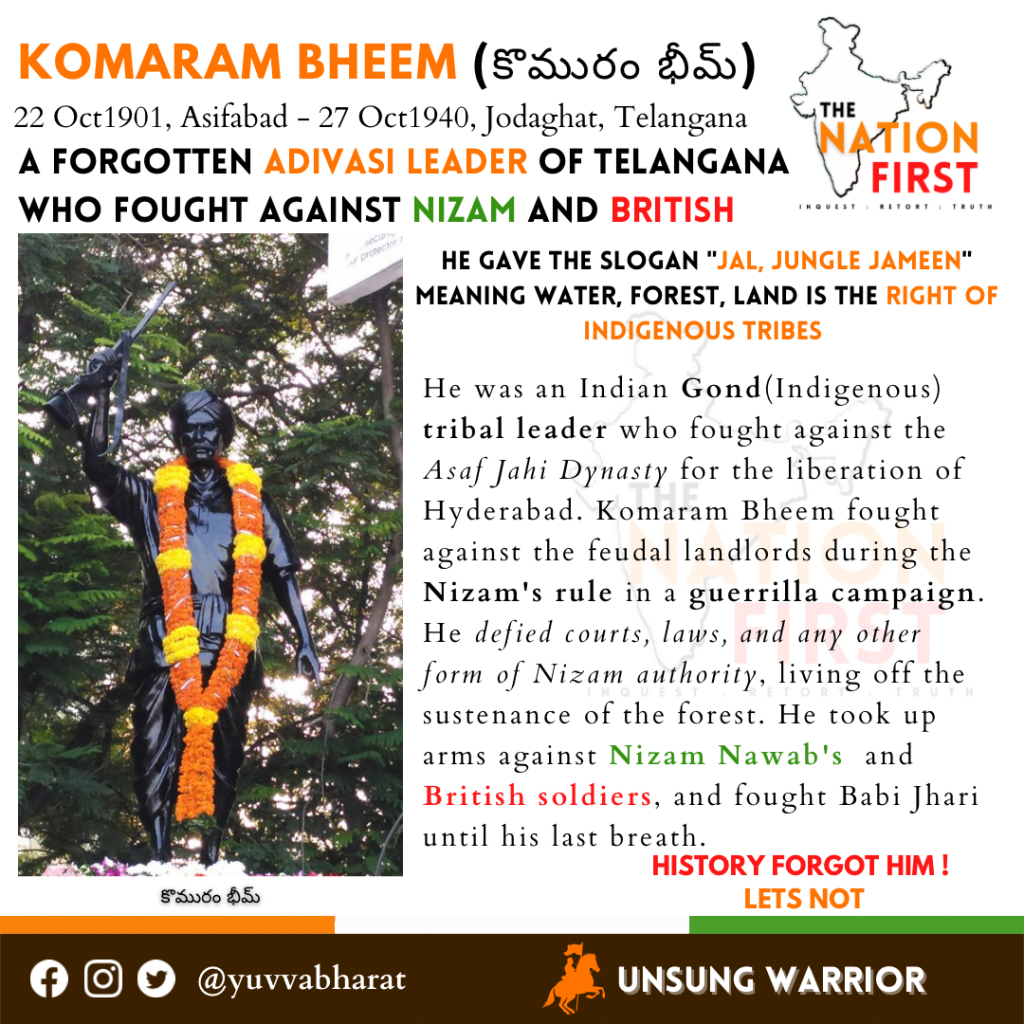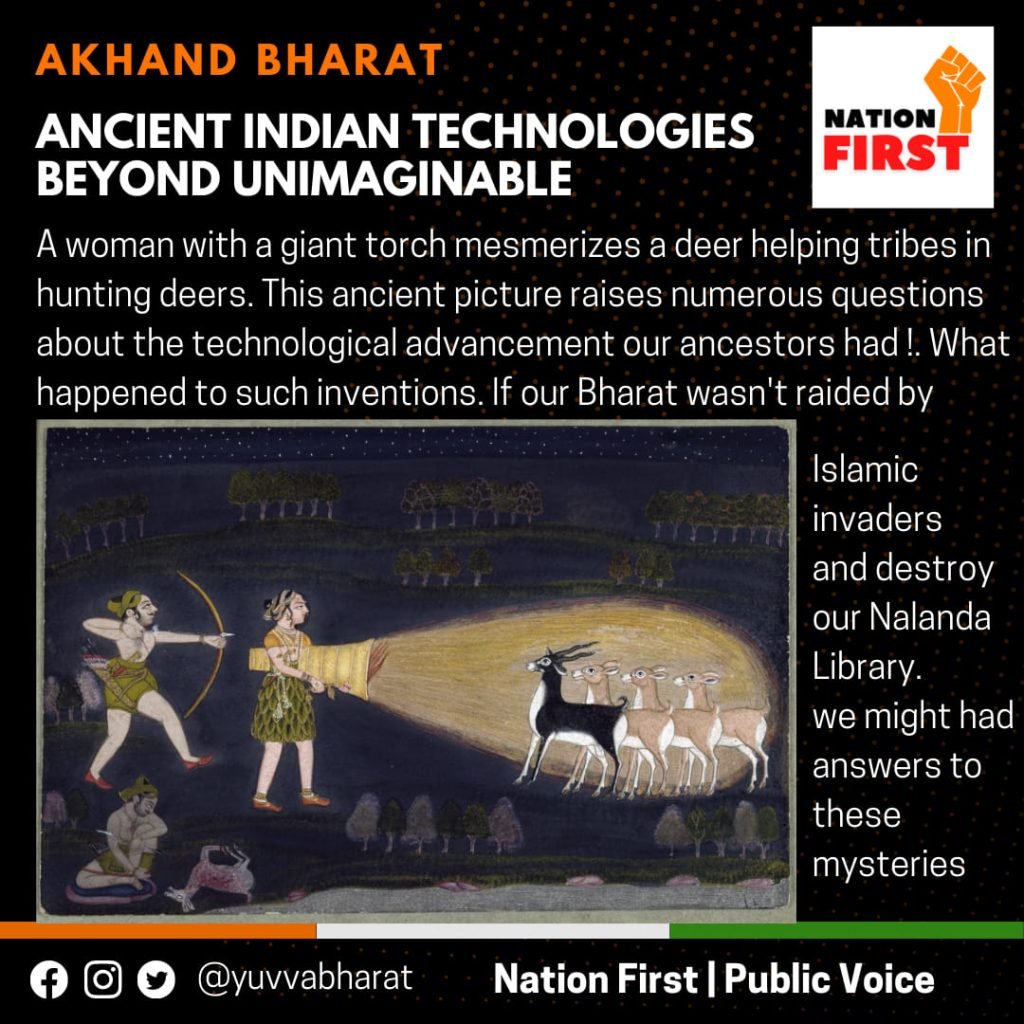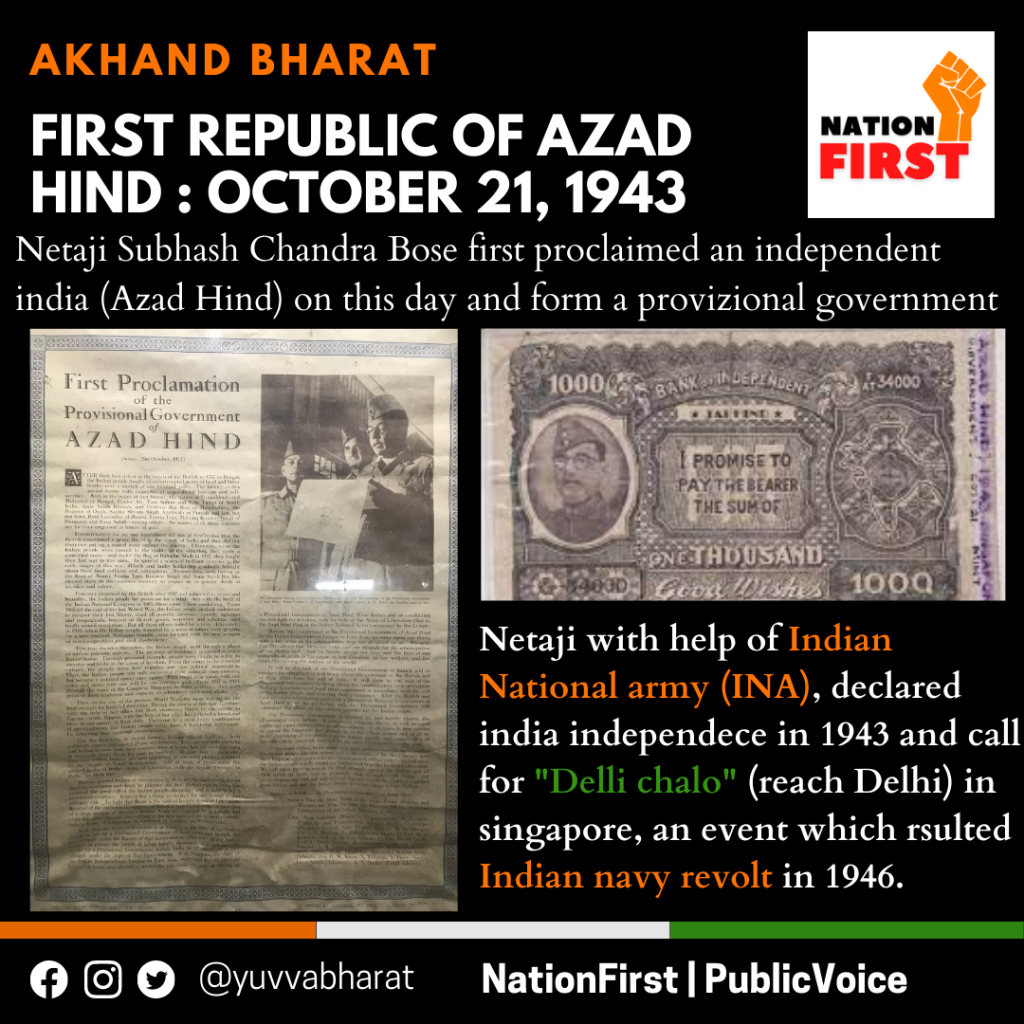Komaram Bheem (కొమురం భీమ్ )alternatively Kumram Bheem, was a rebel leader in British India from the Gond trbies, who in association with other Gond leaders and communist revolutionaries led a protracted low intensity rebellion against the feudal Nizamate of Hyderabad and the British Raj in the eastern part of the princely state during the 1930s which contributed in the culmination of the Telangana Rebellion of 1946.
He was killed by armed policemen in 1940, subsequently lionised as a symbol of rebellion and eulogised in Adivasi and Telugu folklore. Bheem is deified as a pen in Gond culture and is credited for coining the slogan Jal, Jangal, Zameen (transl. Water, Forest, Land) which symbolising a sentiment against encroachment and exploitation, has been adopted by Adivasi movements as a call to action. He is also closely associated with the movement for Telangana statehood.
Early Life
Komaram Bheem was born in Sankepalli, near Adilabad in Hyderabad State, British Indiato a family in the Gondi tribal community. He is generally considered to have been born on 22 October 1901, although some consider it to be in 1900. Bheem grew up in the tribal populated forests within the traditional kingdoms of Chanda and Ballalpur, isolated from the rest of the world and received no formal education. He kept moving from place to place throughout his life as the Gondi people were becoming increasingly victimised by exploitation from zamindars (transl. landlords) and businessmen, and through extortion by the jangaalat police (transl. forest police).
During the 1900s, there was expansion of mining activities and strengthening of state authority in the Gondi region, regulations were introduced and enforced which hampered the subsistence activities of the Gondis. Zamindars were granted lands in their regions and they imposed taxes on Gondi podu farming activities, non-compliance often resulting in severe arbitration including forced amputations. Gondis began migrating out of their traditional villages, the situation led to occasional retaliations and protestations; Bheem’s father was killed by forest officials in one such incident.
Following the death of his father, Bheem and his family moved out to Sankepalli to Sardapur near Karimnagar. The Gonds who had migrated to Sardapur settled in barren land owned by the zamindar Laxman Rao; they began subsistence farming on the land and subsequently became a target for tax extraction. In a confrontation in October 1920, Bheem killed a senior official of the Nizamate, Siddiquesaab who was sent by Rao to enforce the confiscation of crops during the time of harvest. To escape capture, he ran away on foot to the city of Chanda with his friend named Kondal. The two were granted refuge by a local publisher Vitoba who operated a printing press and distribution network across the regional railways for an anti–British anti–Nizamate magazine. Bheem learned to speak and read English, Hindi and Urdu during time working with Vitoba.
Bheem was forced to run away again after Vitoba was arrested, on this occasion, to a tea plantation in Assam with an acquaintance at the Manchiryal railway station. He worked in the plantations for four and a half years, became involved in labour union activities and was eventually arrested for it. Bheem escaped jail within four days, boarded a goods train and returned to Balharshah in the Nizamate. Bheem had heard of the Rampa Rebellion of 1922 led by Alluri Sitarama Raju during his time in Assam; inspired by the rebellion and folklore tales he had heard of Ramji Gond in his childhood, he decided to initiate his own struggle for the rights of the Adivasis on his return. Bheem moved to Kakanghat with family and started working for Lacchu Patel who was the head of a village called Devadam. Leveraging his experience in Assam, he helped Patel in a land litigation against the Asifabad estate which made him well known in the nearby villages and in return was granted permission by Patel for his marriage.
Bheem married a woman named Som Bai, moved to Bhabejhari in the interior of the Gond lands and settled down to cultivate a piece of land. During the time of harvest, he was again approached by forest officials who threatened him to leave arguing that the land belonged to the state. Bheem with his newfound influence was motivated to lobby the Nizam directly and sought to present the grievances of the Adivasis before him but his efforts elicited no response. On having failed to gain any concessions through peaceful means, Bheem came to the conclusion that armed revolution was the only solution.
He formed clandestine associations with the banned Communist Party of India, and started mobilising the Adivasi population at Jodeghat, eventually calling a council of tribal leaders from the twelve traditional districts of Ankusapur, Bhabejhari, Bhimangundi, Chalbaridi, Jodeghat, Kallegaon, Koshaguda, Linepatter, Narsapur, Patnapur, Shivaguda and Tokennavada. The council came to the conclusion of forming a standing guerilla army to protect their lands. Bheem also proposed a plan to declare themselves an independent Gond kingdom, the proposition is the first of its kind for an autonomous Gondwana.
The council was immediately followed by an uprising in the Gondi region which began in 1928, the forces mobilised attacked the landlords in Babejhari and Jodeghat. In response, the Nizam recognised Bheem as their leader and sent the collector at Asifabad to negotiate with him, offering assurances of land grants to the Gonds. In the negotiation, Bheem rejected the initial offer stating that they sought justice and instead demanded regional autonomy for the Gonds, eviction of the forest officials and zamindars, and the release of all Gond prisoners in the penal system with Hyderabad state.
The demands was rejected and the conflict continued as a low intensity guerilla campaign over the following decade, Bheem directly commanded 300 men under him and operated out of Jodeghat. He is credited to have coined the slogan Jal, Jangal, Zameen (transl. Water, Forest, Land) during this period.
Bheem’s whereabouts were eventually found by Kurdu Patel and he was killed in an encounter with armed policemen led the talukdar of Asifabad, Abdul Sattar. 15 others were killed in the encounter and all their bodies were cremated by the police at the spot. The time of his death is disputed, it’s officially recognised to have occurred in October 1940 but Gondi people commemorate it on 8 April 1940.
Bheem Legacy
Komaram Bheem was one of a number of leaders in the Gond rebellion but was lionised as its symbol following his death and over the years eulogised into Adivasi and Telugu folk songs.Bheem has been deified among the animistic Gond Adivasi community through the worship of Bheemal Pen. His death anniversary is commemorated by the Gonds every year on Aswayuja Powrnami, where an event is organized at Jodeghat, the place of his death and his center of operations during the rebellion. His aides Bhadu master and Maru master are considered to have been instrumental in lionising him following his death, in order to motivate demoralised combatants.

Following the death of Bheem, the Hyderabad State employed the Austrian ethnologist Christoph von Fürer-Haimendorf to study that causes of the rebellion. Haimendorf’s work enabled the enactment of the Hyderabad Tribal Areas Regulation 1356 Fasli in 1946. Haimendorf had remarked at the time that “rebellions of aboriginal tribesmen against the authority of the government are among the most tragic conflicts between ruler and ruled” and that “it is always a hopeless struggle of the weak against the strong, the illiterate and uninformed against the organised power of a sophisticated system.” The rebellion itself persisted for years after his death till it merged with the Telangana Rebellion, a peasants uprising led by the communists against the Nizamate.
Government of Telangana and Bheem’s legacy
Bheem’s legacy was largely ignored in the mainstream beyond the folk culture of the impoverished Adivasis of central eastern India and the Telangana movement in Andhra Pradesh. His marginalised status in Indian mainstream history contrasted with his idolisation as a revolutionary figure among Adivasis, for whom he became an exemplification of their own marginalised and exploited status in India even after independence. The slogan of Jal, Jangal, Zameen symbolising a sentiment against encroachment and exploitation, has been adopted by Adivasi communities, particularly the Gonds for their social and political struggles, including as a war cry in the Naxalite–Maoist insurgency. In popular culture, the film Komaram Bheem (1990) directed by Allani Sridhar was created based on his life and won two Nandi Awards.
In the 21st century, with growing support and prominence of the demand for the new state of Telangana, the legacy of Bheem was brought back into the spotlight and began featuring in the more mainstream political discourse and rhetoric.
In 2011, the Andhra Pradesh government announced the construction of a dam and reservoir named after Sri Komaram Bheem Project and the installation of a statue at Tank Bund Road in the city of Hyderabad. Following the establishment of the Telangana state in 2014, the state government allocated ₹25 crore (equivalent to ₹34 crore or US$4.5 million in 2020) for the construction of a Komaram Bheem museum for tribal history at Jodeghat and a memorial at Jodeghat hill rock. The museum and memorial were inaugurated in 2016, and in the same year the Adilabad district was reorganised, part of carved out as the Komaram Bheem district. The location near Jodeghat has become a major tourism destination in Telangana.
Highlights of Bheem
- Komaram Bheem was born in 1901 to Komaram Chinnu and Som Bai in the forests of Asifabad, Telangana
- Bheem belongs to Gond Tribals and decided to fight against the oppression of tribal people at a very small age
- Bheem fought against the Asaf Jahi Dynasty for the freedom of Adivasis
- Komaram Bheem, who came to know about the ongoing atrocities, launched massive agitations against the Nizam government (Telangana and a few parts that were under Nizam’s control) and started guerrilla warfare against their army
- Jode Ghat was the center of Komaram Bheem’s activities and Bheem continued his guerrilla war from 1928 to 1940
- Bheem was greatly inspired by the freedom fighter Alluri Seetha Ramaraju who stood strong against the British during the freedom fight.
- Komaram Bheem is the man behind the birth of the slogan “Jal, Jungle, Zameen” (Water, Forest, Land)
- Komaram Bheem fought against Nizam’s soldiers and breathed his last fighting at Babijhari in the year 1940.
- 72 years after his death, in 2012 Komaram Bheem’s statue was installed at Tank Bund, Hyderabad.
- Puchalapalli Sundariah, the comrade leader of Telangana Rebellion wrote the life history of Komaran Bheem — the tribal hero who dedicated his life for the empowerment of Adivasis.
Latest update
In 2018, S. S. Rajamouli, the director of the Bahubali series announced the film RRR which would incorporate Komaram Bheem and his contemporary Alluri Sitarama Raju as characters. The plot being a work of fiction depicting a friendship between them and taking place in the less documented part of their lives in the 1920s.



